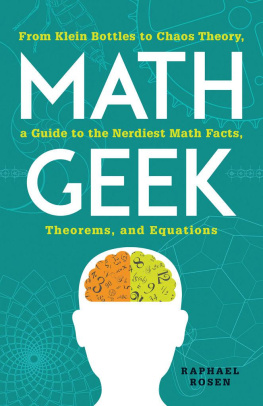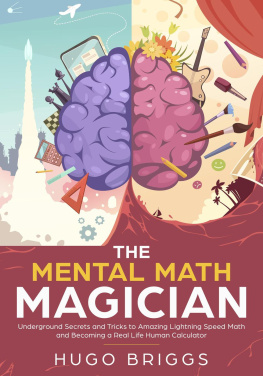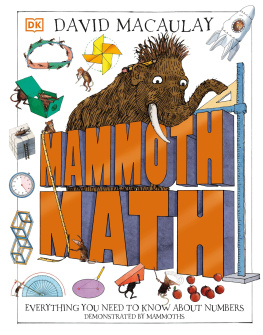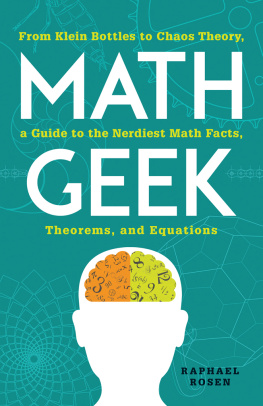MATH GEEK
From Klein Bottles to Chaos Theory, a Guide to the Nerdiest Math Facts, Theorems, and Equations
RAPHAEL ROSEN

Avon, Massachusetts
DEDICATION
To Nathaniel, Jolina, and the rest of my family
CONTENTS
67. How Many Clues Do You Need to Solve a
Sudoku Puzzle?
INTRODUCTION
WHAT DOES IT MEAN TO BE A MATH GEEK? Maybe you enjoyed math classes when you were in school and now do logic puzzles in your spare time. Maybe youve become intrigued by all of the references to math in popular cultureProof, Numb3rs, The Imitation Game, A Beautiful Mindand want to know more. Maybe youre an engineer or a physicist and use advanced math concepts every day. Maybe you have a hard time understanding math and yearn to get a glimpse of a world that so many people find fascinating. Or maybe youre your own kind of geek: after all, there are as many kinds of math geeks as there are theorems.
Whoever you are, in these pages I hope to show you that mathematics is not just a series of rote exercises performed in a classroom. You wont have to memorize anything, and theres no test at the end. I hope to convince you that mathematics is something built into the fabric of reality: a collection of shapes, patterns, numbers, arguments, and, well, little treasures. Math is in the air you breathe, the sidewalks you walk on, and the buses you take to work each morning. What does that mean? To find out, youll have to read on.
Besides showing you that mathematics is a living feature of the world we live in, I also hope to persuade you that math is pretty. Im not saying that equations look good on paper, or that plus and minus signs are like calligraphy. I mean that learning about math is like looking at a sunset, reading a poem, or listening to your favorite band. Math has a beauty that can stop you in your tracks. Have you ever walked out of a movie theater after seeing a great drama, your mind stunned by the performances, sets, and cinematography? Believe it or not, math is like that. Some mathematicians have even argued that math should be included in a list of cultural touchstones that includes Shakespeare, Mozart, and Michelangelo. These math mavens believe that people should study math for its own sake, because not studying it would be a crime on a par with never having read Hamlet. In other words, people should not learn about mathematics simply to get a good score on the SAT. Instead, they should study it to enrich their lives.
Our expedition to find math in our everyday world will take us from pizza to donuts, from online shopping to the GPS features in our smartphones. Well look closely at why, when youre waiting at a bus stop, there wont be a bus for what seems like an eternity, and then suddenly two or three will arrive all at once. Well stop to examine weird vegetables in your local supermarket, and learn how music is translated into a file on your iPod. Well even make sense of strange paradoxes like why adding roads can make traffic worse.
Once you learn the fascinating math concepts hiding in the world around you, youll find an even greater appreciation for mathone that you can share with your fellow commuter when the bus is late... again.
PART 1
SHAPES

The Beauty of Romanesco Broccoli
MATHEMATICAL CONCEPT: SELF-SIMILARITY
HAVE YOU EVER looked closely at the fruits and vegetables in your local supermarket? Some of them are creepy: the yellow Buddhas hand, for instance, looks like a squid creature from an H.P. Lovecraft story. Others are strangely beautiful. Sweet potatoes have a wonderful lumpiness like misshapen hunks of clay; onions have nesting rings like those found in trees; and when you slice open an apple, you can see that the seeds are arranged in a star-shaped configuration thats oddly pleasing. Even ornamental cabbagewhich is sold at garden storeshas a kind of geometric attractiveness.
But nothing in the produce aisle beats the Romanesco broccoli for the ultimate in vegetable beauty. In fact, its hard to take your eyes off it. The Romanesco, a type of Brassica oleracea, or cabbage, has the general shape of a pinecone, but its surface is a riot of smaller pinecone shapes, and on the surface of each of those cones are more cones, and so on. Each of the smaller surface cones looks like the larger, original cone, so much so that if you were to lop off a surface cone, photograph it, and place the photo next to an image of the entire broccoli, it would be difficult to tell which was which.
Mathematicians would say that the shape of the Romanesco is self-similar: if you zoom in on the shape and look closely at a detail, what you see is the same as if you hadnt zoomed in at all. Self-similaritywhen an object looks the same no matter the scaleis also a distinguishing feature of fractals, a kind of shape studied and popularized by mathematician Benoit Mandelbrot. His 1982 book, The Fractal Geometry of Nature, helped introduce this species of object to the world. (The book was largely a revision of his 1977 book called Fractals: Form, Chance and Dimension.) Mandelbrot identified lots of shapes in nature that have this self-similar quality: jagged coastlines, clouds, and the exquisite tracery of veins in a leaf. Nature seems to like self-similar shapes; the more you look for them, the more you find.
THE MANDELBROT SET
Benoit Mandelbrot also studied something thats now called the Mandelbrot set, a set of complex numbers in a sequence that does not approach infinity. When you plot the Mandelbrot set on a graph, it can take on a bulbous shape with a captivating beauty, which is interesting to mathematicians in part because the more you zoom in on any part of it, the more detail you see. In fact, as you zoom, you start to see the original Mandelbrot set shape over and over again.
Measuring the Length of a Coastline: Not as Easy as It Sounds
MATHEMATICAL CONCEPT: MEASUREMENT
WHAT COULD BE MORE straightforward than measuring how long something is? If we want to figure out the length of a table, for instance, we can use a measuring tape. If we want to determine the distance from one town to another, we can drive a car and note the change in the odometer. Or we can get a road map, use a ruler to measure the distance between the two towns, and then use the maps scale to convert inches to miles, or centimeters to kilometers.
But measuring the length of a coastline is more complicated. It turns out that the length of any particular coastline depends on the length of the unit used to measure it. In general, the smaller the measuring unit, the longer the coastline. And in principle, as the measuring unit gets smaller and smaller, the length of a coastline increases to infinity. How can this be?
Like many forms in nature, coastlines are irregular and jagged. Thus, as you zoom in on one you notice more and more detail. If you were peering down at North America from the height of a satellite, for example, the coastline would appear relatively smooth and feature-free. But if you were measuring a coastline by walking, you would observe river inlets, small spits of land, and rocks, among other features. Then, if you were to get on your hands and knees, you could start to account for pebbles and leaves. And if you were to use a microscope, your measurements could include molecules. At each new level of detail, the unit of measurement shrinks, from kilometer to meter to centimeter to micrometer; and each time, the amount of territory to measure increases. If you were to measure the coastline of Great Britain using a stick 100 kilometers (about 62 miles) long, the resulting distance would be more like 2,800 kilometers (approximately 1,700 miles). But if you reduced your measuring stick to 50 kilometers (31 miles), the new total coastline distance would be 3,400 kilometers (2,100 miles).







